北师大版英语八年级下册 Unit 2 Communication Lesson 5 Meeting People 教学设计(表格式)
文档属性
| 名称 | 北师大版英语八年级下册 Unit 2 Communication Lesson 5 Meeting People 教学设计(表格式) | 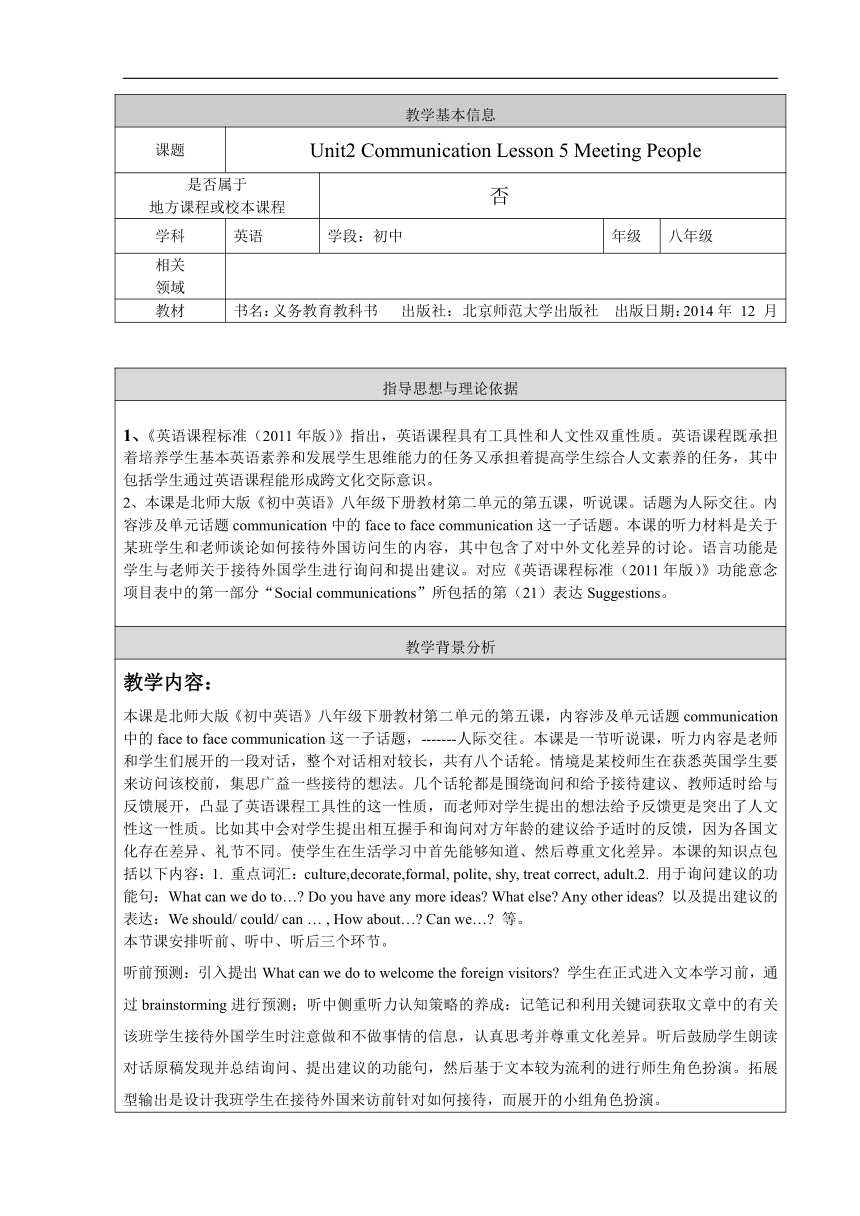 | |
| 格式 | doc | ||
| 文件大小 | 111.0KB | ||
| 资源类型 | 教案 | ||
| 版本资源 | 北师大版 | ||
| 科目 | 英语 | ||
| 更新时间 | 2022-06-16 15:55:08 | ||
图片预览

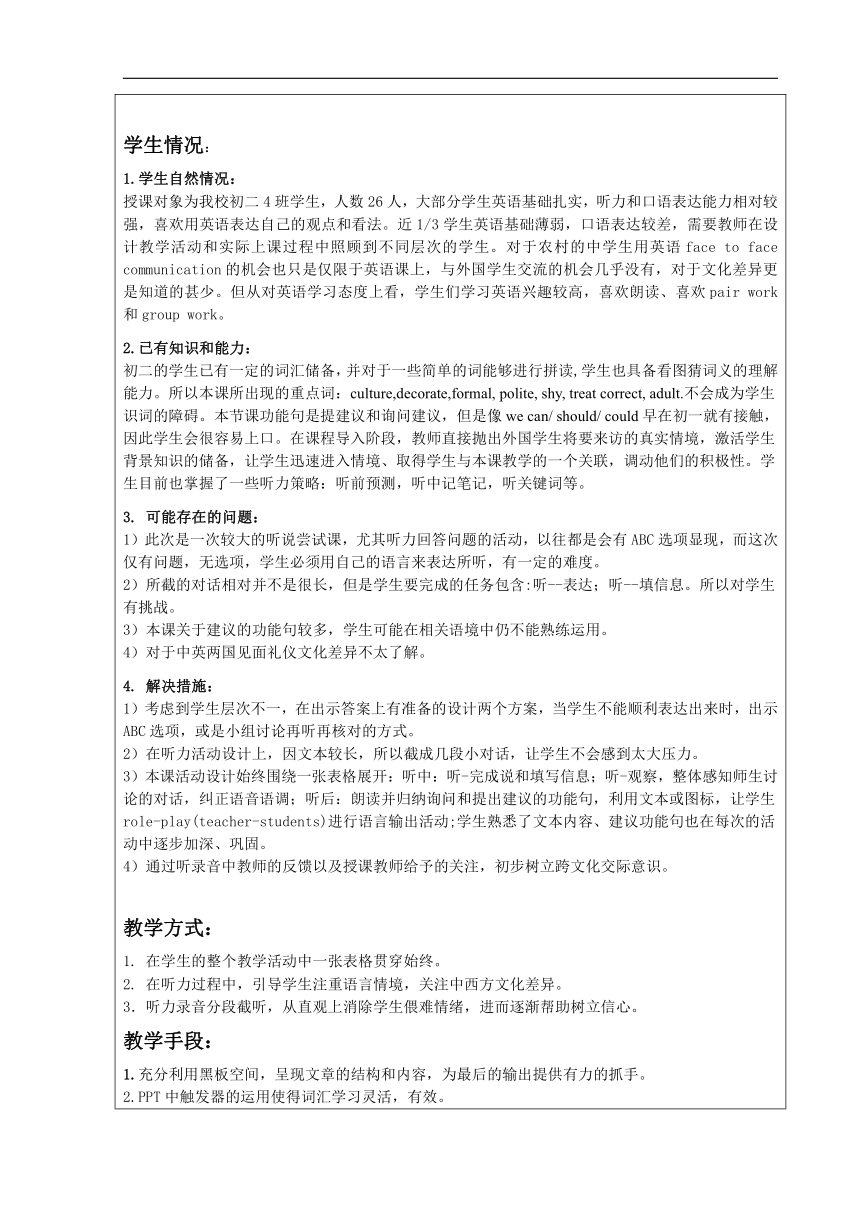
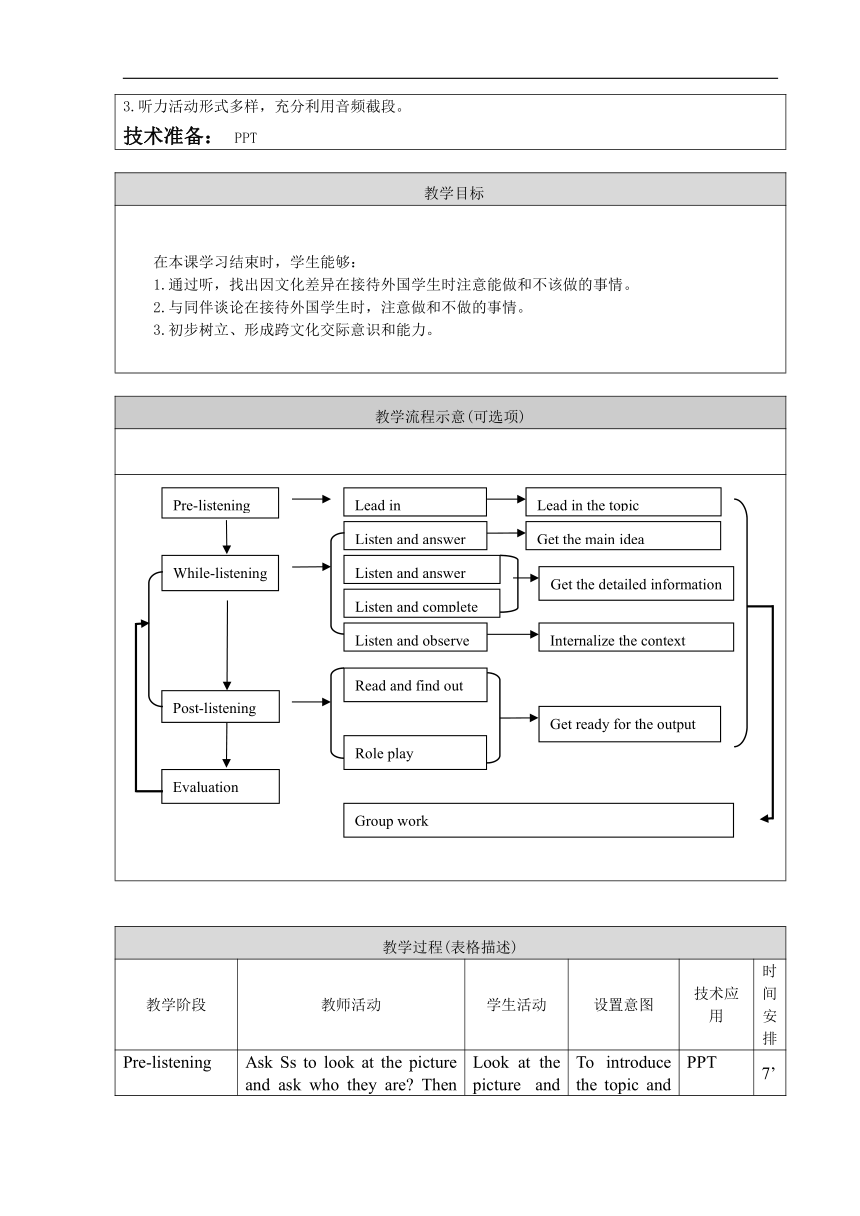
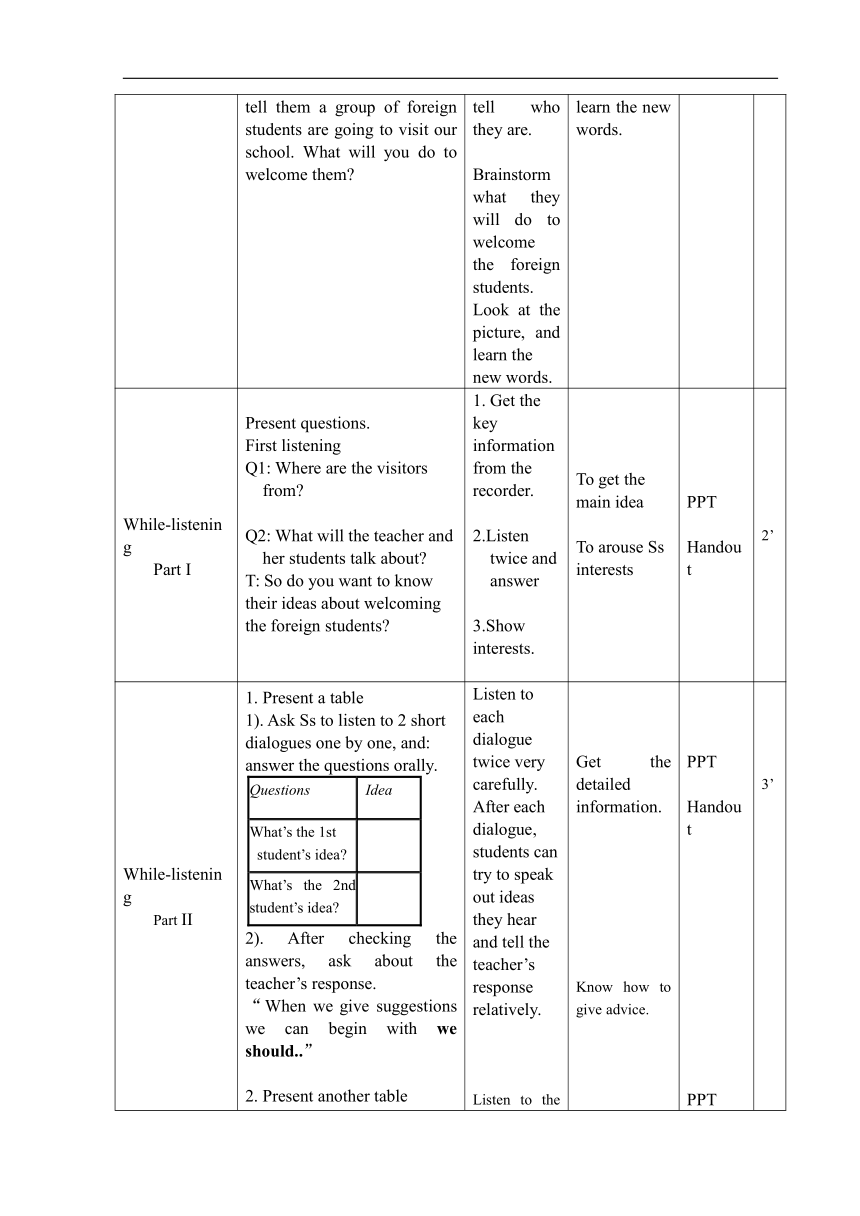
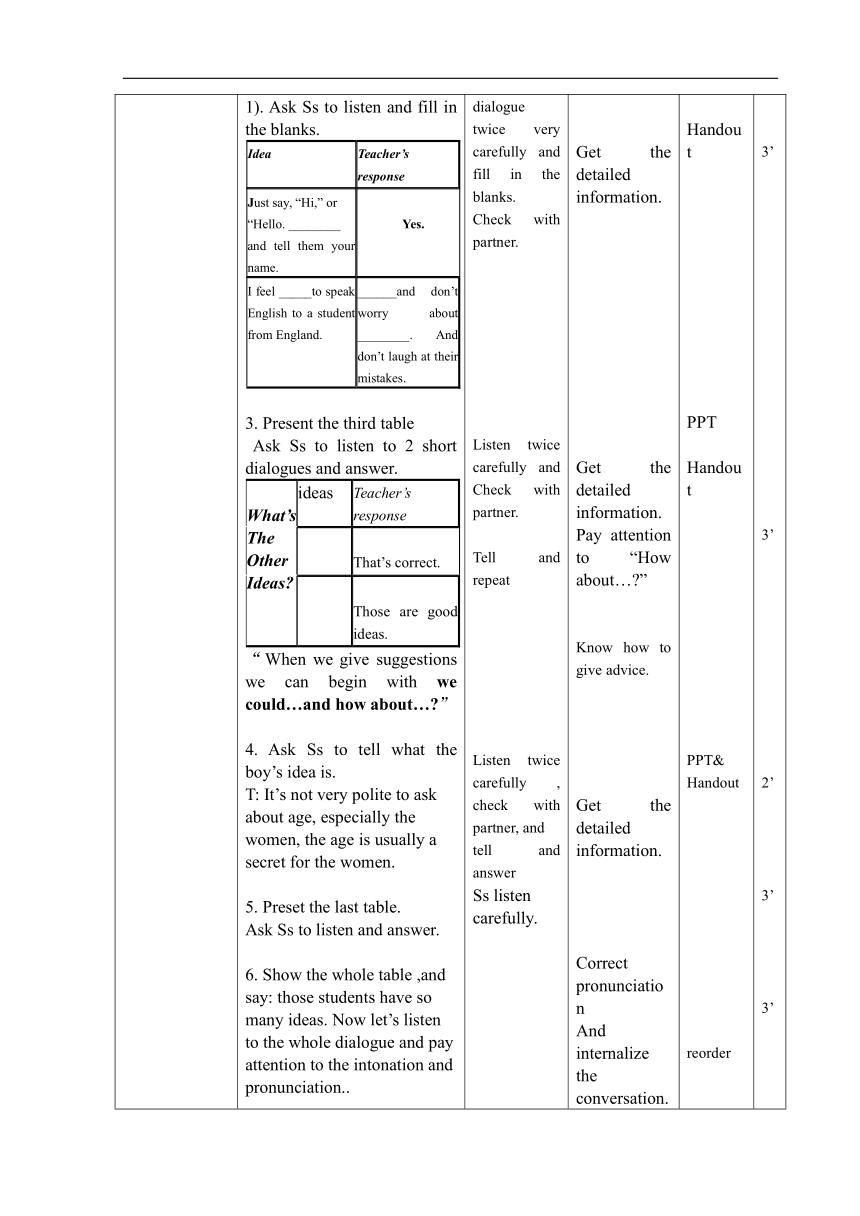
文档简介
教学基本信息
课题 Unit2 Communication Lesson 5 Meeting People
是否属于地方课程或校本课程 否
学科 英语 学段:初中 年级 八年级
相关领域
教材 书名:义务教育教科书 出版社: 北京师范大学出版社 出版日期:2014年 12 月
指导思想与理论依据
1、《英语课程标准(2011年版)》指出,英语课程具有工具性和人文性双重性质。英语课程既承担着培养学生基本英语素养和发展学生思维能力的任务又承担着提高学生综合人文素养的任务,其中包括学生通过英语课程能形成跨文化交际意识。2、本课是北师大版《初中英语》八年级下册教材第二单元的第五课,听说课。话题为人际交往。内容涉及单元话题communication中的face to face communication这一子话题。本课的听力材料是关于某班学生和老师谈论如何接待外国访问生的内容,其中包含了对中外文化差异的讨论。语言功能是学生与老师关于接待外国学生进行询问和提出建议。对应《英语课程标准(2011年版)》功能意念项目表中的第一部分“Social communications”所包括的第(21)表达Suggestions。
教学背景分析
教学内容:本课是北师大版《初中英语》八年级下册教材第二单元的第五课,内容涉及单元话题communication中的face to face communication这一子话题,-------人际交往。本课是一节听说课,听力内容是老师和学生们展开的一段对话,整个对话相对较长,共有八个话轮。情境是某校师生在获悉英国学生要来访问该校前,集思广益一些接待的想法。几个话轮都是围绕询问和给予接待建议、教师适时给与反馈展开,凸显了英语课程工具性的这一性质,而老师对学生提出的想法给予反馈更是突出了人文性这一性质。比如其中会对学生提出相互握手和询问对方年龄的建议给予适时的反馈,因为各国文化存在差异、礼节不同。使学生在生活学习中首先能够知道、然后尊重文化差异。本课的知识点包括以下内容:1. 重点词汇:culture,decorate,formal, polite, shy, treat correct, adult.2. 用于询问建议的功能句:What can we do to… Do you have any more ideas What else Any other ideas 以及提出建议的表达:We should/ could/ can … , How about… Can we… 等。本节课安排听前、听中、听后三个环节。听前预测:引入提出What can we do to welcome the foreign visitors 学生在正式进入文本学习前,通过brainstorming进行预测;听中侧重听力认知策略的养成:记笔记和利用关键词获取文章中的有关该班学生接待外国学生时注意做和不做事情的信息,认真思考并尊重文化差异。听后鼓励学生朗读对话原稿发现并总结询问、提出建议的功能句,然后基于文本较为流利的进行师生角色扮演。拓展型输出是设计我班学生在接待外国来访前针对如何接待,而展开的小组角色扮演。学生情况:1.学生自然情况:授课对象为我校初二4班学生,人数26人,大部分学生英语基础扎实,听力和口语表达能力相对较强,喜欢用英语表达自己的观点和看法。近1/3学生英语基础薄弱,口语表达较差,需要教师在设计教学活动和实际上课过程中照顾到不同层次的学生。对于农村的中学生用英语face to face communication的机会也只是仅限于英语课上,与外国学生交流的机会几乎没有,对于文化差异更是知道的甚少。但从对英语学习态度上看,学生们学习英语兴趣较高,喜欢朗读、喜欢pair work和group work。2.已有知识和能力:初二的学生已有一定的词汇储备,并对于一些简单的词能够进行拼读,学生也具备看图猜词义的理解能力。所以本课所出现的重点词:culture,decorate,formal, polite, shy, treat correct, adult.不会成为学生识词的障碍。本节课功能句是提建议和询问建议,但是像we can/ should/ could早在初一就有接触,因此学生会很容易上口。在课程导入阶段,教师直接抛出外国学生将要来访的真实情境,激活学生背景知识的储备,让学生迅速进入情境、取得学生与本课教学的一个关联,调动他们的积极性。学生目前也掌握了一些听力策略:听前预测,听中记笔记,听关键词等。3. 可能存在的问题:1)此次是一次较大的听说尝试课,尤其听力回答问题的活动,以往都是会有ABC选项显现,而这次仅有问题,无选项,学生必须用自己的语言来表达所听,有一定的难度。2)所截的对话相对并不是很长,但是学生要完成的任务包含:听--表达;听--填信息。所以对学生有挑战。3)本课关于建议的功能句较多,学生可能在相关语境中仍不能熟练运用。4)对于中英两国见面礼仪文化差异不太了解。4. 解决措施:1)考虑到学生层次不一,在出示答案上有准备的设计两个方案,当学生不能顺利表达出来时,出示ABC选项,或是小组讨论再听再核对的方式。2)在听力活动设计上,因文本较长,所以截成几段小对话,让学生不会感到太大压力。3)本课活动设计始终围绕一张表格展开:听中:听-完成说和填写信息;听-观察,整体感知师生讨论的对话,纠正语音语调;听后:朗读并归纳询问和提出建议的功能句,利用文本或图标,让学生role-play(teacher-students)进行语言输出活动;学生熟悉了文本内容、建议功能句也在每次的活动中逐步加深、巩固。4)通过听录音中教师的反馈以及授课教师给予的关注,初步树立跨文化交际意识。教学方式:1. 在学生的整个教学活动中一张表格贯穿始终。2. 在听力过程中,引导学生注重语言情境,关注中西方文化差异。3.听力录音分段截听,从直观上消除学生偎难情绪,进而逐渐帮助树立信心。教学手段: 1.充分利用黑板空间,呈现文章的结构和内容,为最后的输出提供有力的抓手。2.PPT中触发器的运用使得词汇学习灵活,有效。3.听力活动形式多样,充分利用音频截段。技术准备: PPT
教学目标
在本课学习结束时,学生能够: 1.通过听,找出因文化差异在接待外国学生时注意能做和不该做的事情。 2.与同伴谈论在接待外国学生时,注意做和不做的事情。 3.初步树立、形成跨文化交际意识和能力。
教学流程示意(可选项)
教学过程(表格描述)
教学阶段 教师活动 学生活动 设置意图 技术应用 时间安排
Pre-listening Ask Ss to look at the picture and ask who they are Then tell them a group of foreign students are going to visit our school. What will you do to welcome them Look at the picture and tell who they are.Brainstorm what they will do to welcome the foreign students. Look at the picture, and learn thenew words. To introduce the topic and learn the new words. PPT 7’
While-listening Part I Present questions.First listening Q1: Where are the visitors from Q2: What will the teacher and her students talk about T: So do you want to know their ideas about welcoming the foreign students 1. Get the key information from the recorder. 2.Listen twice and answer3.Show interests. To get the main ideaTo arouse Ss interests PPTHandout 2’
While-listeningPart II 1. Present a table1). Ask Ss to listen to 2 short dialogues one by one, and:answer the questions orally. Questions IdeaWhat’s the 1st student’s idea What’s the 2nd student’s idea 2). After checking the answers, ask about the teacher’s response.“When we give suggestions we can begin with we should..”2. Present another table1). Ask Ss to listen and fill in the blanks.IdeaTeacher’s responseJust say, “Hi,” or “Hello. ________and tell them your name. Yes.I feel _____to speak English to a student from England. ______and don’t worry about ________. And don’t laugh at their mistakes.3. Present the third table Ask Ss to listen to 2 short dialogues and answer.What’s TheOther Ideas ideasTeacher’s responseThat’s correct.Those are good ideas.“When we give suggestions we can begin with we could…and how about… ”4. Ask Ss to tell what the boy’s idea is.T: It’s not very polite to ask about age, especially the women, the age is usually a secret for the women.5. Preset the last table.Ask Ss to listen and answer.6. Show the whole table ,and say: those students have so many ideas. Now let’s listen to the whole dialogue and pay attention to the intonation and pronunciation.. Listen to each dialogue twice very carefully. After each dialogue, students cantry to speak out ideas they hear and tell the teacher’s response relatively.Listen to the dialogue twice very carefully and fill in the blanks.Check with partner.Listen twice carefully and Check with partner. Tell and repeat Listen twice carefully , check with partner, and tell and answerSs listen carefully. Get the detailed information.Know how to give advice.Get the detailed information.Get the detailed information.Pay attention to “How about… ”Know how to give advice.Get the detailed information.Correct pronunciationAnd internalize the conversation. PPTHandoutPPTHandoutPPTHandoutPPT&Handoutreorder 3’3’3’2’3’3’
Post-listening 1. Point at the blackboard and ask Ss how the teacher asks for suggestions And have Ss read and underline sentences about asking for suggestions.2. Have Ss work in groups to make a role-play, according to the context. “You can role play it by reading or you can also challenge yourself, of course I prepare the pictures for you here.”3.Present the School Notice for Today:A group of students and teachers from England are coming to visit our school next month. Let’s do something to give them an unforgettable experience in our school. Have Ss think of ideas and suggestions, have a discussion with group, and then make a conversation in the group. Ss read and underline sentences about asking for suggestions.Practise and role playRead the notice.Work in groups to make a conversation about what they can do to welcome the students from England. Internalize the context.Make summary of function of suggestions.Make languages into practice. Language in use tape scriptPPTPPT&Handout 23’2’’’7’
Homework 1. Read the conversation fluently.The foreign students and teachers are leaving our school, think of ideas and suggestions for the foreign students’ goodbye party. Design a plan.
Blackboard designing Lesson5 Meeting People Asking for suggestions Offering suggestions What can / could/ should we do We can/ could/ should… Do you have any more ideas I think wee should…. What else How about… Any other ideas Can I …. It’s a good idea to … Why don’t you…
学习效果评价设计
OkGoodExcellent1. I can pronounce and know the meaning of the words: culture, decorate, formal, shy, adult and treat .1-2个3-4个5-6个2. I can ask for ideas and suggestions.1-2点3-4点5点以上3. I can give ideas and suggestions.1-2点3-4点5点以上
本教学设计与以往或其他教学设计相比的特点(300-500字数)
1. 突出英语课程标准工具性和人文性的双重性质,注意渗透文化意识。 本课对话情境是某校师生在获悉英国学生要来访问该校前,围绕询问和给予接待建议、教师适时给与反馈展开,凸显了英语课程工具性的这一性质,而老师对学生提出的想法给予反馈更是突出了人文性这一性质。比如教师会对学生提出的相互握手和询问对方年龄的建议给予适时的反馈,原因就是基于文化差异所致,使学生在生活学习中首先能够知道、然后尊重文化差异。2. 语言学习策略渗透,听力回答问题,无选项,鼓励学生预测、记笔记、记关键词来组织语言进行表达。3. 考虑到学生层次不一,在出示答案上有准备的设计两个方案,当学生不能顺利表达出来时,出示ABC选项,帮助学生树立自信心而不是总是感到挫败感。4. 在听力活动设计上,因文本较长,所以截成几段小对话,让学生不会感到太大压力。5. 新词教授通过语块的形式:图--短语结合,这样学生不是学孤零零的生词,而是真正做到把新词与新课联系在一起,有利于他们高效的学习掌握新词的
教学反思(300-500字数)
本课是一节听说课,整个对话相对较长,共有八个话轮。情境是某校师生在获悉英国学生要来访问该校前,集思广益一些接待的想法。因此在导入阶段,采用出示图片直接入话题,激活他们的背景知识储备。在这时师引到学生接待外国人时需要注意什么、不做什么。为“跨文化交际意识”做了有效的铺垫。同时导入也增强了学生的好奇心。本节课听中,始终围绕一个表格进行,有目的的把听力长音频截成几个小段,侧重听力认知策略的养成:记笔记和利用关键词获取文章中的有关该班学生接待外国学生时注意做和不做事情的信息,认真思考并尊重文化差异。学生基本达到了目标。成功的截段,确实消除学生偎难情绪,也帮助树立了信心。语言输出在前面搭设好台阶的基础上结合图片进行,效果很好:通过图标,学生在脑海里转换为句子,让图唤起学生的语言,达到交际的目的。 整个听说课,学生参与度较高,学生能够运用所学实践交流、交际的目的。
附录1
Study plan for Lesson 5 Meeting People
Listening and speaking
-While listening-
1. Listen to the teacher and answer the questions.
1).Where are the visitors from
2). What will the teacher and her students talk about
2. Listen to the dialogues and finish the relative tasks.
Dialogue 1 listen and answer
Question Idea
What’s the 1st student’s idea
Dialogue 2 listen and answer
Question Idea
What’s the 2nd student’s idea
Dialogue 3 Listen and fill in the blanks
Questions Idea Teacher’s response
What’s the 3rd student’s idea Just say, “Hi,” or “Hello. ___________,” and tell them your name. Yes.
What’s the 4th student’s idea I feel _____to speak English to a student from England. ______ and don’t worry about ____________.And don’t laugh at their mistakes.
Dialogue 4&5 Listen and answer
Question Idea Teacher’s response
What are the other ideas That’s correct.
Those are good ideas.
Dialogue 6 Listen, answer and fill in the blanks
Question Idea Teacher’s response
What’s the boy’s idea You can ask the students but don’t ask ________or adults, because it’s not very _________
Dialogue 7 Listen and answer
Question Idea Teacher’s response
1. What’s the girl’s idea Yes. So I hope you remember these things and treat our guests well
2. What’s the boy’s idea
3. Listen to the conversation carefully. Pay attention to the intonation
and pronunciation.
-Post listening-
1. Read the conversation and underline the sentences that the teacher asks for suggestions.
2. Work in groups of 4 or 5, according to the context, role play the conversation.
Teacher: A group of students and teachers from England are coming to our school, what can we do to welcome foreign students Student: We can …Teacher: Yes, be friendly. Any more ideas Student: How about….. Teacher: It’s a bit too formal. ……
3. What can you do to welcome them Think of ideas and suggestions, and then make a conversation with your partners.
School notice for todayA group of students and teachers from England are coming to visit our school next week. Let’s do something to give them an unforgettable experience in our school.
附录2:
Teacher: OK class. The students from England are coming tomorrow. So what can we do to welcome them Hands up! Li Hong
Boy: We should smile and say hello.
Teacher: Yes, be friendly. Good. Wang Wei
Girl: I think we should shake hands with them.
Teacher: Well, young people from England don’t usually shake hands when they introduce themselves. It’s a bit too formal. Perhaps they’ll shake hands with me. Do you have any more ideas Anybody
Boy: Just say,“Hi,”or“Hello. Nice to meet you,” and tell them your name.
Teacher: Yes.
Girl: I feel shy to speak English to a student from England!
Teacher: Relax and don’t worry about making mistakes. And they can only say a few things in Chinese so don’t laugh at their mistakes either. What else
Girl: We could talk about food or find out what kind of music they like.
Teacher: That’s correct.
Boy: How about asking about their trip or sports or the weather
Teacher: Those are good ideas.
Boy: Can we ask how old they are
Teacher: Well, most of them are about your age and yes, you can. But don’t ask their teacher or any adults though. It’s not very polite. OK, any other ideas
Girl: We can help them find their classroom and show them the library.
Boy: We could play basketball with them too.
Teacher: Yes. So I hope you remember these things and treat our guests well.
Lead in the topic
Lead in
Pre-listening
Get the main idea
Listen and answer
Listen and answer
While-listeningingg
Get the detailed information
Listen and complete
Internalize the context
Listen and observe
Read and find out
Post-listening
Get ready for the output
Role play
Evaluation
Group work
课题 Unit2 Communication Lesson 5 Meeting People
是否属于地方课程或校本课程 否
学科 英语 学段:初中 年级 八年级
相关领域
教材 书名:义务教育教科书 出版社: 北京师范大学出版社 出版日期:2014年 12 月
指导思想与理论依据
1、《英语课程标准(2011年版)》指出,英语课程具有工具性和人文性双重性质。英语课程既承担着培养学生基本英语素养和发展学生思维能力的任务又承担着提高学生综合人文素养的任务,其中包括学生通过英语课程能形成跨文化交际意识。2、本课是北师大版《初中英语》八年级下册教材第二单元的第五课,听说课。话题为人际交往。内容涉及单元话题communication中的face to face communication这一子话题。本课的听力材料是关于某班学生和老师谈论如何接待外国访问生的内容,其中包含了对中外文化差异的讨论。语言功能是学生与老师关于接待外国学生进行询问和提出建议。对应《英语课程标准(2011年版)》功能意念项目表中的第一部分“Social communications”所包括的第(21)表达Suggestions。
教学背景分析
教学内容:本课是北师大版《初中英语》八年级下册教材第二单元的第五课,内容涉及单元话题communication中的face to face communication这一子话题,-------人际交往。本课是一节听说课,听力内容是老师和学生们展开的一段对话,整个对话相对较长,共有八个话轮。情境是某校师生在获悉英国学生要来访问该校前,集思广益一些接待的想法。几个话轮都是围绕询问和给予接待建议、教师适时给与反馈展开,凸显了英语课程工具性的这一性质,而老师对学生提出的想法给予反馈更是突出了人文性这一性质。比如其中会对学生提出相互握手和询问对方年龄的建议给予适时的反馈,因为各国文化存在差异、礼节不同。使学生在生活学习中首先能够知道、然后尊重文化差异。本课的知识点包括以下内容:1. 重点词汇:culture,decorate,formal, polite, shy, treat correct, adult.2. 用于询问建议的功能句:What can we do to… Do you have any more ideas What else Any other ideas 以及提出建议的表达:We should/ could/ can … , How about… Can we… 等。本节课安排听前、听中、听后三个环节。听前预测:引入提出What can we do to welcome the foreign visitors 学生在正式进入文本学习前,通过brainstorming进行预测;听中侧重听力认知策略的养成:记笔记和利用关键词获取文章中的有关该班学生接待外国学生时注意做和不做事情的信息,认真思考并尊重文化差异。听后鼓励学生朗读对话原稿发现并总结询问、提出建议的功能句,然后基于文本较为流利的进行师生角色扮演。拓展型输出是设计我班学生在接待外国来访前针对如何接待,而展开的小组角色扮演。学生情况:1.学生自然情况:授课对象为我校初二4班学生,人数26人,大部分学生英语基础扎实,听力和口语表达能力相对较强,喜欢用英语表达自己的观点和看法。近1/3学生英语基础薄弱,口语表达较差,需要教师在设计教学活动和实际上课过程中照顾到不同层次的学生。对于农村的中学生用英语face to face communication的机会也只是仅限于英语课上,与外国学生交流的机会几乎没有,对于文化差异更是知道的甚少。但从对英语学习态度上看,学生们学习英语兴趣较高,喜欢朗读、喜欢pair work和group work。2.已有知识和能力:初二的学生已有一定的词汇储备,并对于一些简单的词能够进行拼读,学生也具备看图猜词义的理解能力。所以本课所出现的重点词:culture,decorate,formal, polite, shy, treat correct, adult.不会成为学生识词的障碍。本节课功能句是提建议和询问建议,但是像we can/ should/ could早在初一就有接触,因此学生会很容易上口。在课程导入阶段,教师直接抛出外国学生将要来访的真实情境,激活学生背景知识的储备,让学生迅速进入情境、取得学生与本课教学的一个关联,调动他们的积极性。学生目前也掌握了一些听力策略:听前预测,听中记笔记,听关键词等。3. 可能存在的问题:1)此次是一次较大的听说尝试课,尤其听力回答问题的活动,以往都是会有ABC选项显现,而这次仅有问题,无选项,学生必须用自己的语言来表达所听,有一定的难度。2)所截的对话相对并不是很长,但是学生要完成的任务包含:听--表达;听--填信息。所以对学生有挑战。3)本课关于建议的功能句较多,学生可能在相关语境中仍不能熟练运用。4)对于中英两国见面礼仪文化差异不太了解。4. 解决措施:1)考虑到学生层次不一,在出示答案上有准备的设计两个方案,当学生不能顺利表达出来时,出示ABC选项,或是小组讨论再听再核对的方式。2)在听力活动设计上,因文本较长,所以截成几段小对话,让学生不会感到太大压力。3)本课活动设计始终围绕一张表格展开:听中:听-完成说和填写信息;听-观察,整体感知师生讨论的对话,纠正语音语调;听后:朗读并归纳询问和提出建议的功能句,利用文本或图标,让学生role-play(teacher-students)进行语言输出活动;学生熟悉了文本内容、建议功能句也在每次的活动中逐步加深、巩固。4)通过听录音中教师的反馈以及授课教师给予的关注,初步树立跨文化交际意识。教学方式:1. 在学生的整个教学活动中一张表格贯穿始终。2. 在听力过程中,引导学生注重语言情境,关注中西方文化差异。3.听力录音分段截听,从直观上消除学生偎难情绪,进而逐渐帮助树立信心。教学手段: 1.充分利用黑板空间,呈现文章的结构和内容,为最后的输出提供有力的抓手。2.PPT中触发器的运用使得词汇学习灵活,有效。3.听力活动形式多样,充分利用音频截段。技术准备: PPT
教学目标
在本课学习结束时,学生能够: 1.通过听,找出因文化差异在接待外国学生时注意能做和不该做的事情。 2.与同伴谈论在接待外国学生时,注意做和不做的事情。 3.初步树立、形成跨文化交际意识和能力。
教学流程示意(可选项)
教学过程(表格描述)
教学阶段 教师活动 学生活动 设置意图 技术应用 时间安排
Pre-listening Ask Ss to look at the picture and ask who they are Then tell them a group of foreign students are going to visit our school. What will you do to welcome them Look at the picture and tell who they are.Brainstorm what they will do to welcome the foreign students. Look at the picture, and learn thenew words. To introduce the topic and learn the new words. PPT 7’
While-listening Part I Present questions.First listening Q1: Where are the visitors from Q2: What will the teacher and her students talk about T: So do you want to know their ideas about welcoming the foreign students 1. Get the key information from the recorder. 2.Listen twice and answer3.Show interests. To get the main ideaTo arouse Ss interests PPTHandout 2’
While-listeningPart II 1. Present a table1). Ask Ss to listen to 2 short dialogues one by one, and:answer the questions orally. Questions IdeaWhat’s the 1st student’s idea What’s the 2nd student’s idea 2). After checking the answers, ask about the teacher’s response.“When we give suggestions we can begin with we should..”2. Present another table1). Ask Ss to listen and fill in the blanks.IdeaTeacher’s responseJust say, “Hi,” or “Hello. ________and tell them your name. Yes.I feel _____to speak English to a student from England. ______and don’t worry about ________. And don’t laugh at their mistakes.3. Present the third table Ask Ss to listen to 2 short dialogues and answer.What’s TheOther Ideas ideasTeacher’s responseThat’s correct.Those are good ideas.“When we give suggestions we can begin with we could…and how about… ”4. Ask Ss to tell what the boy’s idea is.T: It’s not very polite to ask about age, especially the women, the age is usually a secret for the women.5. Preset the last table.Ask Ss to listen and answer.6. Show the whole table ,and say: those students have so many ideas. Now let’s listen to the whole dialogue and pay attention to the intonation and pronunciation.. Listen to each dialogue twice very carefully. After each dialogue, students cantry to speak out ideas they hear and tell the teacher’s response relatively.Listen to the dialogue twice very carefully and fill in the blanks.Check with partner.Listen twice carefully and Check with partner. Tell and repeat Listen twice carefully , check with partner, and tell and answerSs listen carefully. Get the detailed information.Know how to give advice.Get the detailed information.Get the detailed information.Pay attention to “How about… ”Know how to give advice.Get the detailed information.Correct pronunciationAnd internalize the conversation. PPTHandoutPPTHandoutPPTHandoutPPT&Handoutreorder 3’3’3’2’3’3’
Post-listening 1. Point at the blackboard and ask Ss how the teacher asks for suggestions And have Ss read and underline sentences about asking for suggestions.2. Have Ss work in groups to make a role-play, according to the context. “You can role play it by reading or you can also challenge yourself, of course I prepare the pictures for you here.”3.Present the School Notice for Today:A group of students and teachers from England are coming to visit our school next month. Let’s do something to give them an unforgettable experience in our school. Have Ss think of ideas and suggestions, have a discussion with group, and then make a conversation in the group. Ss read and underline sentences about asking for suggestions.Practise and role playRead the notice.Work in groups to make a conversation about what they can do to welcome the students from England. Internalize the context.Make summary of function of suggestions.Make languages into practice. Language in use tape scriptPPTPPT&Handout 23’2’’’7’
Homework 1. Read the conversation fluently.The foreign students and teachers are leaving our school, think of ideas and suggestions for the foreign students’ goodbye party. Design a plan.
Blackboard designing Lesson5 Meeting People Asking for suggestions Offering suggestions What can / could/ should we do We can/ could/ should… Do you have any more ideas I think wee should…. What else How about… Any other ideas Can I …. It’s a good idea to … Why don’t you…
学习效果评价设计
OkGoodExcellent1. I can pronounce and know the meaning of the words: culture, decorate, formal, shy, adult and treat .1-2个3-4个5-6个2. I can ask for ideas and suggestions.1-2点3-4点5点以上3. I can give ideas and suggestions.1-2点3-4点5点以上
本教学设计与以往或其他教学设计相比的特点(300-500字数)
1. 突出英语课程标准工具性和人文性的双重性质,注意渗透文化意识。 本课对话情境是某校师生在获悉英国学生要来访问该校前,围绕询问和给予接待建议、教师适时给与反馈展开,凸显了英语课程工具性的这一性质,而老师对学生提出的想法给予反馈更是突出了人文性这一性质。比如教师会对学生提出的相互握手和询问对方年龄的建议给予适时的反馈,原因就是基于文化差异所致,使学生在生活学习中首先能够知道、然后尊重文化差异。2. 语言学习策略渗透,听力回答问题,无选项,鼓励学生预测、记笔记、记关键词来组织语言进行表达。3. 考虑到学生层次不一,在出示答案上有准备的设计两个方案,当学生不能顺利表达出来时,出示ABC选项,帮助学生树立自信心而不是总是感到挫败感。4. 在听力活动设计上,因文本较长,所以截成几段小对话,让学生不会感到太大压力。5. 新词教授通过语块的形式:图--短语结合,这样学生不是学孤零零的生词,而是真正做到把新词与新课联系在一起,有利于他们高效的学习掌握新词的
教学反思(300-500字数)
本课是一节听说课,整个对话相对较长,共有八个话轮。情境是某校师生在获悉英国学生要来访问该校前,集思广益一些接待的想法。因此在导入阶段,采用出示图片直接入话题,激活他们的背景知识储备。在这时师引到学生接待外国人时需要注意什么、不做什么。为“跨文化交际意识”做了有效的铺垫。同时导入也增强了学生的好奇心。本节课听中,始终围绕一个表格进行,有目的的把听力长音频截成几个小段,侧重听力认知策略的养成:记笔记和利用关键词获取文章中的有关该班学生接待外国学生时注意做和不做事情的信息,认真思考并尊重文化差异。学生基本达到了目标。成功的截段,确实消除学生偎难情绪,也帮助树立了信心。语言输出在前面搭设好台阶的基础上结合图片进行,效果很好:通过图标,学生在脑海里转换为句子,让图唤起学生的语言,达到交际的目的。 整个听说课,学生参与度较高,学生能够运用所学实践交流、交际的目的。
附录1
Study plan for Lesson 5 Meeting People
Listening and speaking
-While listening-
1. Listen to the teacher and answer the questions.
1).Where are the visitors from
2). What will the teacher and her students talk about
2. Listen to the dialogues and finish the relative tasks.
Dialogue 1 listen and answer
Question Idea
What’s the 1st student’s idea
Dialogue 2 listen and answer
Question Idea
What’s the 2nd student’s idea
Dialogue 3 Listen and fill in the blanks
Questions Idea Teacher’s response
What’s the 3rd student’s idea Just say, “Hi,” or “Hello. ___________,” and tell them your name. Yes.
What’s the 4th student’s idea I feel _____to speak English to a student from England. ______ and don’t worry about ____________.And don’t laugh at their mistakes.
Dialogue 4&5 Listen and answer
Question Idea Teacher’s response
What are the other ideas That’s correct.
Those are good ideas.
Dialogue 6 Listen, answer and fill in the blanks
Question Idea Teacher’s response
What’s the boy’s idea You can ask the students but don’t ask ________or adults, because it’s not very _________
Dialogue 7 Listen and answer
Question Idea Teacher’s response
1. What’s the girl’s idea Yes. So I hope you remember these things and treat our guests well
2. What’s the boy’s idea
3. Listen to the conversation carefully. Pay attention to the intonation
and pronunciation.
-Post listening-
1. Read the conversation and underline the sentences that the teacher asks for suggestions.
2. Work in groups of 4 or 5, according to the context, role play the conversation.
Teacher: A group of students and teachers from England are coming to our school, what can we do to welcome foreign students Student: We can …Teacher: Yes, be friendly. Any more ideas Student: How about….. Teacher: It’s a bit too formal. ……
3. What can you do to welcome them Think of ideas and suggestions, and then make a conversation with your partners.
School notice for todayA group of students and teachers from England are coming to visit our school next week. Let’s do something to give them an unforgettable experience in our school.
附录2:
Teacher: OK class. The students from England are coming tomorrow. So what can we do to welcome them Hands up! Li Hong
Boy: We should smile and say hello.
Teacher: Yes, be friendly. Good. Wang Wei
Girl: I think we should shake hands with them.
Teacher: Well, young people from England don’t usually shake hands when they introduce themselves. It’s a bit too formal. Perhaps they’ll shake hands with me. Do you have any more ideas Anybody
Boy: Just say,“Hi,”or“Hello. Nice to meet you,” and tell them your name.
Teacher: Yes.
Girl: I feel shy to speak English to a student from England!
Teacher: Relax and don’t worry about making mistakes. And they can only say a few things in Chinese so don’t laugh at their mistakes either. What else
Girl: We could talk about food or find out what kind of music they like.
Teacher: That’s correct.
Boy: How about asking about their trip or sports or the weather
Teacher: Those are good ideas.
Boy: Can we ask how old they are
Teacher: Well, most of them are about your age and yes, you can. But don’t ask their teacher or any adults though. It’s not very polite. OK, any other ideas
Girl: We can help them find their classroom and show them the library.
Boy: We could play basketball with them too.
Teacher: Yes. So I hope you remember these things and treat our guests well.
Lead in the topic
Lead in
Pre-listening
Get the main idea
Listen and answer
Listen and answer
While-listeningingg
Get the detailed information
Listen and complete
Internalize the context
Listen and observe
Read and find out
Post-listening
Get ready for the output
Role play
Evaluation
Group work
同课章节目录
- Unit 1 Technology and the Future
- Lesson 1 Schools of the Future
- Lesson 2 Online Life
- Lesson 3 Tomorrow's Jobs
- Communication Workshop
- Unit 2 Communication
- Lesson 4 Animal Talk
- Lesson 5 Meeting People
- Lesson 6 The Texting Generation
- Communication Workshop
- Unit 3 Festivals and Holidays
- Lesson 7 Chinese New Year
- Lesson 8 A Picnic
- Lesson 9 Thanksgiving
- Communication Workshop
- Unit 4 Dealing with Problems
- Lesson 10 Problem Page
- Lesson 11 Online Time
- Lesson 12 Generation Gap
- Communication Workshop
- Unit 5 Memories
- Lesson 13 A Daughter's Letter
- Lesson 14 Grandpa's Memories
- Lesson 15 Life in the 1950s
- Communication Workshop
- Unit 6 Detectives
- Lesson 16 A Detective Story (I)
- Lesson 17 A Detective Story (II)
- Lesson 18 The Mystery Writer
- Communication Workshop
